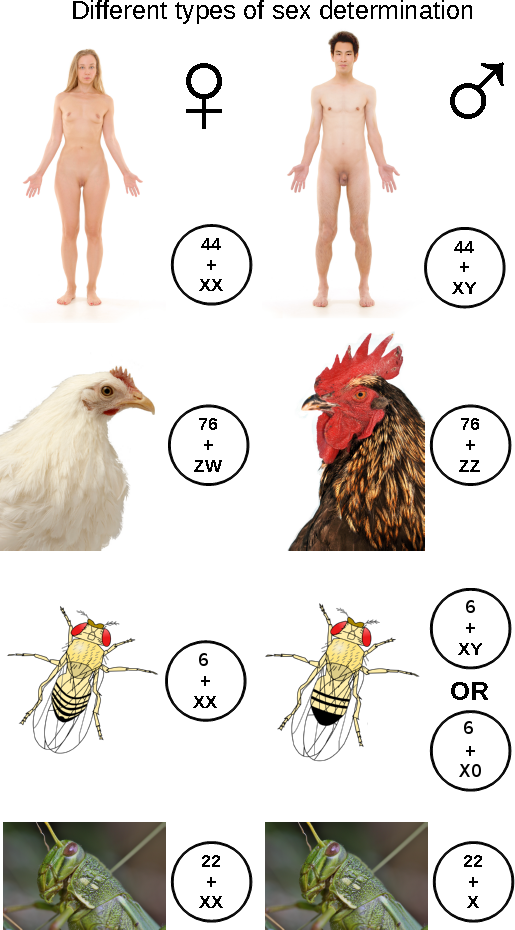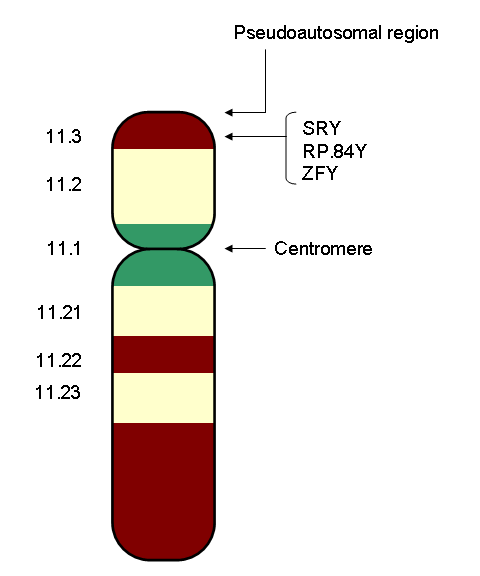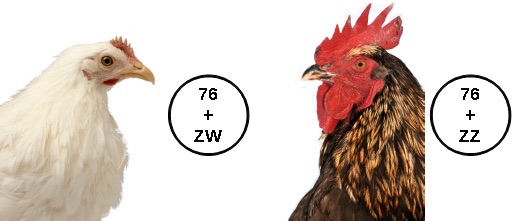|
Z0 Sex-determination System
The ZO sex-determination system is a system that determines the sex of offspring in several moths. In those species, there is one sex chromosome, Z. Males have two Z chromosomes, whereas females have one Z. Males are ZZ, while females are ZO. See also *Y-chromosomal Adam * Sex Determination in ''Silene'' * Sex-determination system * Sexual differentiation * Haplodiploid sex-determination system * XY sex-determination system * XO sex-determination system * ZW sex-determination system * Temperature-dependent sex determination * X chromosome * Y chromosome The Y chromosome is one of two sex chromosomes (allosomes) in therian mammals, including humans, and many other animals. The other is the X chromosome. Y is normally the sex-determining chromosome in many species, since it is the presence or abse ... References Sex-determination systems Lepidopterology Chromosomes Insects Moths {{genetics-stub ... [...More Info...] [...Related Items...] OR: [Wikipedia] [Google] [Baidu] |
Moth
Moths are a paraphyletic group of insects that includes all members of the order Lepidoptera that are not butterflies, with moths making up the vast majority of the order. There are thought to be approximately 160,000 species of moth, many of which have yet to be described. Most species of moth are nocturnal, but there are also crepuscular and diurnal species. Differences between butterflies and moths While the butterflies form a monophyletic group, the moths, comprising the rest of the Lepidoptera, do not. Many attempts have been made to group the superfamilies of the Lepidoptera into natural groups, most of which fail because one of the two groups is not monophyletic: Microlepidoptera and Macrolepidoptera, Heterocera and Rhopalocera, Jugatae and Frenatae, Monotrysia and Ditrysia.Scoble, MJ 1995. The Lepidoptera: Form, function and diversity. Oxford, UK: Oxford University Press; 404 p. Although the rules for distinguishing moths from butterflies are not well establishe ... [...More Info...] [...Related Items...] OR: [Wikipedia] [Google] [Baidu] |
Y-chromosomal Adam
In human genetics, the Y-chromosomal most recent common ancestor (Y-MRCA, informally known as Y-chromosomal Adam) is the patrilineal most recent common ancestor (MRCA) from whom all currently living humans are descended. He is the most recent male from whom all living humans are descended through an unbroken line of their male ancestors. The term Y-MRCA reflects the fact that the Y chromosomes of all currently living human males are directly derived from the Y chromosome of this remote ancestor. The analogous concept of the matrilineal most recent common ancestor is known as "Mitochondrial Eve" (mt-MRCA, named for the matrilineal transmission of mtDNA), the most recent woman from whom all living humans are descended matrilineally. As with "Mitochondrial Eve", the title of "Y-chromosomal Adam" is not permanently fixed to a single individual, but can advance over the course of human history as paternal lineages become extinct. Estimates of the time when Y-MRCA lived have also shifte ... [...More Info...] [...Related Items...] OR: [Wikipedia] [Google] [Baidu] |
Sex Determination In Silene
''Silene'' is a flowering plant genus that has evolved a dioecious reproductive system. This is made possible through heteromorphic sex chromosomes expressed as XY. ''Silene'' recently evolved sex chromosomes 5-10 million years ago and are widely used by geneticists and biologists to study the mechanisms of sex determination since they are one of only 39 species across 14 families of angiosperm that possess sex-determining genes. ''Silene'' are studied because of their ability to produce offspring with a plethora of reproductive systems. The common inference drawn from such studies is that the sex of the offspring is determined by the Y chromosome. Evolution of Sex Chromosomes Biologists have found that sex chromosomes in plants originated from pairs of autosomes. As these chromosomes diverge from their autosomal ancestor and from each other as a homologous pair, they have the potential to increase or decrease in size due to mutation and recombination. In the case of ''Sile ... [...More Info...] [...Related Items...] OR: [Wikipedia] [Google] [Baidu] |
Sex-determination System
A sex-determination system is a biological system that determines the development of sexual characteristics in an organism. Most organisms that create their offspring using sexual reproduction have two sexes. In some species there are hermaphrodites. There are also some species that are only one sex due to parthenogenesis, the act of a female reproducing without fertilization. In some species, sex determination is genetic: males and females have different alleles or even different genes that specify their sexual morphology. In animals this is often accompanied by chromosomal differences, generally through combinations of XY, ZW, XO, ZO chromosomes, or haplodiploidy. The sexual differentiation is generally triggered by a main gene (a "sex locus"), with a multitude of other genes following in a domino effect. In other cases, sex of a fetus is determined by environmental variables (such as temperature). The details of some sex-determination systems are not yet fully underst ... [...More Info...] [...Related Items...] OR: [Wikipedia] [Google] [Baidu] |
Sexual Differentiation
Sexual differentiation is the process of development of the sex differences between males and females from an undifferentiated zygote. Sex determination is often distinct from sex differentiation; sex determination is the designation for the development stage towards either male or female, while sex differentiation is the pathway towards the development of the phenotype. In many species, testicular or ovarian differentiation begins with appearance of Sertoli cells in males and granulosa cells in females. As male and female individuals develop from embryos into mature adults, sex differences at many levels develop, such as genes, chromosomes, gonads, hormones, anatomy, and psyche. Beginning with determination of sex by genetic and/or environmental factors, humans and other organisms proceed down different pathways of differentiation as they grow and develop. These processes are not fixed, and can change over one organism's lifetime or over many generations evolutionarily. Sex ... [...More Info...] [...Related Items...] OR: [Wikipedia] [Google] [Baidu] |
Haplodiploid Sex-determination System
Haplodiploidy is a sex-determination system in which males develop from unfertilized eggs and are haploid, and females develop from fertilized eggs and are diploid. Haplodiploidy is sometimes called arrhenotoky. Haplodiploidy determines the sex in all members of the insect orders Hymenoptera ( bees, ants, and wasps) and Thysanoptera ('thrips'). The system also occurs sporadically in some spider mites, Hemiptera, Coleoptera (bark beetles), and rotifers. In this system, sex is determined by the number of sets of chromosomes an individual receives. An offspring formed from the union of a sperm and an egg develops as a female, and an unfertilized egg develops as a male. This means that the males have half the number of chromosomes that a female has, and are haploid. The haplodiploid sex-determination system has a number of peculiarities. For example, a male has no father and cannot have sons, but he has a grandfather and can have grandsons. Additionally, if a eusocial-insect colony ... [...More Info...] [...Related Items...] OR: [Wikipedia] [Google] [Baidu] |
XY Sex-determination System
The XY sex-determination system is a sex-determination system used to classify many mammals, including humans, some insects (''Drosophila''), some snakes, some fish (guppies), and some plants (''Ginkgo'' tree). In this system, the sex of an individual is determined by a pair of sex chromosomes. Females have two of the same kind of sex chromosome (XX), and are called the homogametic sex. Males have two different kinds of sex chromosomes (XY), and are called the heterogametic sex. In humans, the presence of the Y chromosome is responsible for triggering male development; in the absence of the Y chromosome, the fetus will undergo female development. There are various exceptions, such as individuals with Klinefelter syndrome (who have XXY chromosomes), Swyer syndrome (women with XY chromosomes), and XX male syndrome (men with XX chromosomes), however these exceptions are rare. In most species with XY sex determination, an organism must have at least one X chromosome in order to sur ... [...More Info...] [...Related Items...] OR: [Wikipedia] [Google] [Baidu] |
XO Sex-determination System
The XO sex-determination system (sometimes X0 sex-determination system) is a system that some species of insects, arachnids, and mammals use to determine the sex of offspring. In this system, there is only one sex chromosome, referred to as X. Males only have one X chromosome (XO), while females have two (XX). The letter O (sometimes a zero) signifies the lack of a second X. Maternal gametes always contain an X chromosome, so the sex of the animals' offspring depends on whether a sex chromosome is present in the male gamete. Its sperm normally contains either one X chromosome or no sex chromosomes at all. This system determines the sex of offspring among: * Most arachnidsBull, James J.; ''Evolution of sex determining mechanisms''; p. 17 with the exception of mites where a small majority are haplodiploid, * Almost all apterygote and Paleopteran insects (e.g., dragonflies, silverfish) * Most exopterygote insects (e.g., grasshoppers, crickets, cockroaches) * Some nematodes, cr ... [...More Info...] [...Related Items...] OR: [Wikipedia] [Google] [Baidu] |
ZW Sex-determination System
The ZW sex-determination system is a chromosomal system that determines the sex of offspring in birds, some fish and crustaceans such as the giant river prawn, some insects (including butterflies and moths), the schistosome family of flatworms, and some reptiles, e.g. majority of snakes, lacertid lizards and monitors including Komodo dragons. It is also used in some plants where it has probably evolved independently on several occasions. The letters Z and W are used to distinguish this system from the XY sex-determination system. In this system, females have a pair of dissimilar ZW chromosomes, and males have two similar ZZ chromosomes. In contrast to the XY sex-determination system and the X0 sex-determination system, where the sperm determines the sex, in the ZW system, the ovum determines the sex of the offspring. Males are the homogametic sex (ZZ), while females are the heterogametic sex (ZW). The Z chromosome is larger and has more genes, like the X chromosome in the XY sys ... [...More Info...] [...Related Items...] OR: [Wikipedia] [Google] [Baidu] |
Temperature-dependent Sex Determination
Temperature-dependent sex determination (TSD) is a type of environmental sex determination in which the temperatures experienced during embryonic/larval development determine the sex of the offspring. It is only observed in reptiles and teleost fish. TSD differs from the chromosomal sex-determination systems common among vertebrates. It is the most studied type of environmental sex determination (ESD). Some other conditions, e.g. density, pH, and environmental background color, are also observed to alter sex ratio, which could be classified either as temperature-dependent sex determination or temperature-dependent sex differentiation, depending on the involved mechanisms. As sex-determining mechanisms, TSD and genetic sex determination (GSD) should be considered in an equivalent manner, which can lead to reconsidering the status of fish species that are claimed to have TSD when submitted to extreme temperatures instead of the temperature experienced during development in the wild, si ... [...More Info...] [...Related Items...] OR: [Wikipedia] [Google] [Baidu] |
X Chromosome
The X chromosome is one of the two sex-determining chromosomes (allosomes) in many organisms, including mammals (the other is the Y chromosome), and is found in both males and females. It is a part of the XY sex-determination system and XO sex-determination system. The X chromosome was named for its unique properties by early researchers, which resulted in the naming of its counterpart Y chromosome, for the next letter in the alphabet, following its subsequent discovery. Discovery It was first noted that the X chromosome was special in 1890 by Hermann Henking in Leipzig. Henking was studying the testicles of ''Pyrrhocoris'' and noticed that one chromosome did not take part in meiosis. Chromosomes are so named because of their ability to take up staining (''chroma'' in Greek means ''color''). Although the X chromosome could be stained just as well as the others, Henking was unsure whether it was a different class of object and consequently named it ''X element'', which later be ... [...More Info...] [...Related Items...] OR: [Wikipedia] [Google] [Baidu] |
Y Chromosome
The Y chromosome is one of two sex chromosomes (allosomes) in therian mammals, including humans, and many other animals. The other is the X chromosome. Y is normally the sex-determining chromosome in many species, since it is the presence or absence of Y that determines the male or female sex of offspring produced in sexual reproduction. In mammals, the Y chromosome contains the gene SRY, which triggers male development. The DNA in the human Y chromosome is composed of about 59 million base pairs, making it similar in size to chromosome 19. The Y chromosome is passed only from father to son. With a 30% difference between humans and chimpanzees, the Y chromosome is one of the fastest-evolving parts of the human genome. The human Y chromosome carries an estimated 100–200 genes, with between 45 and 73 of these being protein-coding. All single-copy Y-linked genes are hemizygous (present on only one chromosome) except in cases of aneuploidy such as XYY syndrome or XXYY syndrome. ... [...More Info...] [...Related Items...] OR: [Wikipedia] [Google] [Baidu] |






